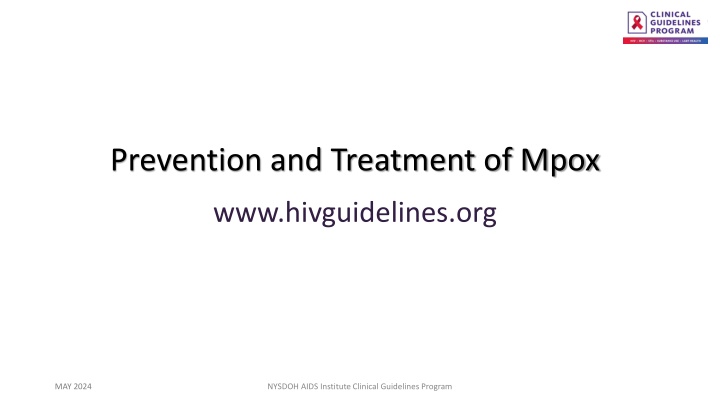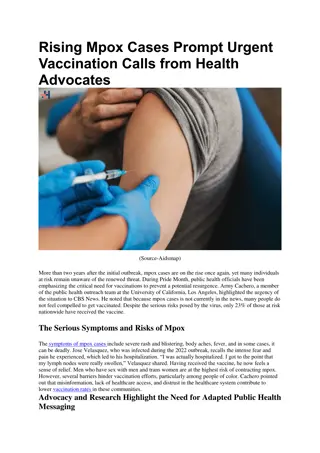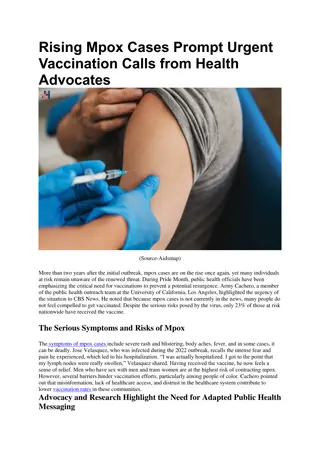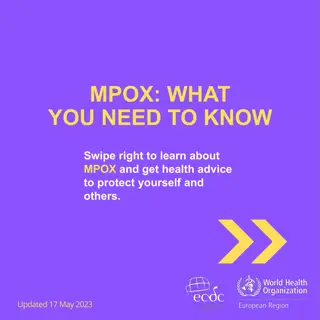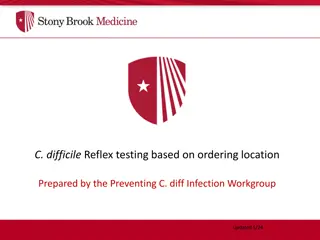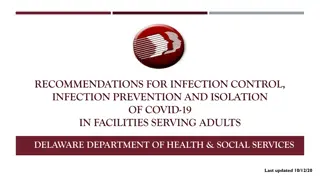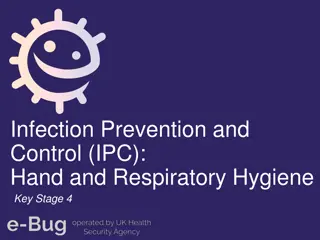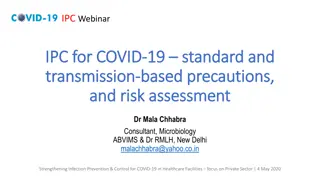Guidelines for Prevention and Treatment of Mpox Infection
This guideline provides information on Mpox (monkeypox) including its prevention, diagnosis, and treatment. It aims to increase clinicians' awareness of the disease, offer evidence-based recommendations, and highlight key points related to Mpox infection, especially focusing on Clade II. The guidelines also cover the clinical presentation of Mpox, emphasizing skin rash, systemic symptoms, mucosal involvement, and the higher risk in immunocompromised individuals.
Download Presentation

Please find below an Image/Link to download the presentation.
The content on the website is provided AS IS for your information and personal use only. It may not be sold, licensed, or shared on other websites without obtaining consent from the author.If you encounter any issues during the download, it is possible that the publisher has removed the file from their server.
You are allowed to download the files provided on this website for personal or commercial use, subject to the condition that they are used lawfully. All files are the property of their respective owners.
The content on the website is provided AS IS for your information and personal use only. It may not be sold, licensed, or shared on other websites without obtaining consent from the author.
E N D
Presentation Transcript
Prevention and Treatment of Mpox www.hivguidelines.org MAY 2024 NYSDOH AIDS Institute Clinical Guidelines Program
Terminology Terminology In November 2022, the CDC aligned its terminology with that of the WHO and adopted the term mpox to refer to monkeypox, to reduce negative effects, including stigma, associated with the use of the term monkeypox. Mpox refers to the disease caused by infection with the human monkeypox virus (MPXV), a member of the Orthopoxvirus genus related to the smallpox virus, but the use of the 2 terms and associated abbreviations is not standardized. The NYSDOH AI guideline uses the term mpox to refer to the virus and the associated disease. MONTH YEAR NYSDOH AIDS Institute Clinical Guidelines Program www.hivguidelines.org
Purpose of This Guideline Purpose of This Guideline Increase clinicians awareness of and ability to recognize the common clinical manifestations of mpox and diagnose the disease in their patients. Provide clinicians with evidence-based recommendations on primary prevention, diagnostic testing, and supportive care and treatment of mpox. Increase clinicians awareness of recommended precautions to reduce occupational exposure to and community transmission of mpox. MAY 2024 NYSDOH AIDS Institute Clinical Guidelines Program www.hivguidelines.org
Key Points: Clade I and Clade II Mpox Key Points: Clade I and Clade II Mpox This guideline is intended to provide guidance for mpox prevention and treatment in general; however, because clade IIb dominated the 2022 worldwide outbreak, the majority of evidence supporting the clinical descriptions and recommendations pertain to clade II mpox. For recommendations on testing if clade I mpox is suspected, such as in a patient who traveled to the Democratic Republic of Congo within 21 days, care providers in New York City can call the Provider Access Line at 1-866-692-3641; care providers in other counties in New York State can call the Office of Sexual Health and Epidemiology at 1-518- 474-3598 during business hours or 1-866-881-2809 during evenings, weekends, and holidays. MAY 2024 NYSDOH AIDS Institute Clinical Guidelines Program www.hivguidelines.org
Mpox Clinical Presentation Mpox Clinical Presentation Mpox is characterized by a skin rash that can be macular, papular, vesicular, or pustular. Lesions in different stages may be present simultaneously. Skin rash may or may not be accompanied by a systemic prodrome of fever, malaise, headache, myalgias, and lymphadenopathy. Mucosal involvement, especially proctitis or pharyngitis, is common. Coinfection with sexually transmitted infections is common. Immunocompromised individuals, including those with advanced HIV, are more likely to develop severe manifestations. MAY 2024 NYSDOH AIDS Institute Clinical Guidelines Program www.hivguidelines.org
Mpox Transmission Prevention and Infection Mpox Transmission Prevention and Infection Control for Healthcare Providers Control for Healthcare Providers Healthcare providers: Use of personal protective equipment, including a gown, gloves, eyewear, and an N-95 or comparable respirator mask, will help prevent occupational exposure in healthcare providers who are evaluating or collecting a specimen from a patient with suspected mpox. There is no need to unroof lesions before swabbing, and this practice may increase the risk of needlestick injury and occupational infection. MAY 2024 NYSDOH AIDS Institute Clinical Guidelines Program www.hivguidelines.org
Mpox Transmission Prevention and Infection Mpox Transmission Prevention and Infection Control for Patients Control for Patients Patients: Although, ideally, patients with mpox will isolate at home and remain separate from other people, this may not always be feasible. To reduce the risk of community transmission, advise patients with confirmed or suspected mpox to do the following until all lesions have healed and other symptoms have resolved: Avoid skin-to-skin and sexual contact Avoid sharing clothing, bed linens, and other soft, porous materials that may have come into contact with a lesion Avoid sharing eating or personal hygiene utensils, such as razors; if items must be shared, wash and disinfect after each use Avoid exposing other people to lesions; if an individual with mpox lesions must be in shared or public spaces, covering all lesions with clothing, bandages, or gloves can prevent transmission Wear a medical mask if in close proximity with other people for more than a brief encounter (per CDC) MAY 2024 NYSDOH AIDS Institute Clinical Guidelines Program www.hivguidelines.org
Recommendations: Mpox Prevention Recommendations: Mpox Prevention Clinicians should recommend the MVA (brand name JYNNEOS) 2-dose vaccine series to individuals 18 years old who are at risk of acquiring mpox. (A2) Clinicians should recommend the MVA 2-dose vaccine series to individuals between 6 months and 18 years old who are at risk of acquiring mpox. (A3) In August 2022, the FDA issued an EUA for emergency use of the JYNNEOS vaccine in individuals <18 years old. Clinicians should encourage individuals being vaccinated with MVA to receive both doses in the series for optimal protection. (A2) Clinicians should not offer vaccination to individuals with prior laboratory- confirmed mpox. (A3) Clinicians should recommend the MVA vaccine as PEP to individuals who have been exposed to mpox within the past 14 days and for whom vaccination may reduce the risk of infection or decrease symptoms if infection has occurred. (A2) Clinicians should vaccinate individuals with HIV who are at risk of acquiring mpox regardless of CD4 count or viral load. (A2) MAY 2024 NYSDOH AIDS Institute Clinical Guidelines Program www.hivguidelines.org
CDC Recommendations for Mpox Vaccination CDC Recommendations for Mpox Vaccination Mpox vaccination should be offered to: People who had known or suspected exposure to someone with mpox People who had a sex partner in the past 2 weeks who was diagnosed with mpox Gay, bisexual, and other men who have sex with men, and transgender or nonbinary people (including adolescents who fall into any of these categories) who, in the past 6 months, have had: - A new diagnosis of 1 or more sexually transmitted infections (e.g., chlamydia, gonorrhea, syphilis) - More than 1 sex partner People who have had any of the following in the past 6 months: - Sex at a commercial sex venue - Sex in association with a large public event in a geographic area where mpox transmission is occurring - Sex in exchange for money or other items People who are sex partners of people with the above risks People who anticipate experiencing any of the above scenarios People with HIV or other causes of immunosuppression who have had recent or anticipate potential mpox exposure People who work with orthopoxviruses in a laboratory MAY 2024 NYSDOH AIDS Institute Clinical Guidelines Program www.hivguidelines.org
Recommendations: Recommendations: Mpox Presentation and Diagnosis Mpox Presentation and Diagnosis Before evaluating people with suspected mpox, clinicians should don personal protective equipment, including a gown, an N95 respirator or comparable mask, eye protection, and gloves. (A3) To diagnose mpox, clinicians should obtain 4 swabs for PCR testing: 2 specimens each taken from swabs of 2 skin lesions, whenever possible, preferably in different stages and at different body sites, without unroofing lesions. (A3) Clinicians should recommend HIV antibody/antigen testing and STI testing (e.g., syphilis serologies and exposure-site gonorrhea and chlamydia NAAT) for any patient with suspected or confirmed sexually acquired mpox. (A3) See the NYSDOH AI guideline HIV Testing. Clinicians should recommend that patients with suspected or confirmed mpox avoid exposing others to lesions to reduce mpox transmission. (A*) MAY 2024 NYSDOH AIDS Institute Clinical Guidelines Program www.hivguidelines.org
CDC Transmission Prevention Recommendations CDC Transmission Prevention Recommendations Isolate in the home if feasible Avoid skin-to-skin and sexual contact Avoid sharing of clothing, bed linens, and other soft, porous materials that may have come into contact with a lesion Avoid sharing of eating or personal hygiene utensils, such as razors; if items must be shared, wash and disinfect after each use Avoid exposing other people to lesions; when in public or shared spaces, cover all lesions with clothing, bandages, or gloves; wear a medical mask if in close proximity with other people for more than a brief encounter Wear a medical mask if in close proximity with other people for more than a brief encounter In individuals with suspected mpox, the above should be continued until mpox has been ruled out. For those with confirmed mpox, precautions should be continued until all lesions have crusted, crusts have separated, and a new layer of skin has formed underneath. MAY 2024 NYSDOH AIDS Institute Clinical Guidelines Program www.hivguidelines.org
Stages of Stages of Mpox Mpox Lesions Lesions Notes: a. Photographs collected by the authors with patient consent. b. See also Centers for Disease Control and Prevention Mpox > Clinical Recognition. MAY 2024 NYSDOH AIDS Institute Clinical Guidelines Program www.hivguidelines.org
Key Points: Mpox Presentation and Diagnosis Key Points: Mpox Presentation and Diagnosis Test for mpox in patients who present with a rash that is potentially consistent with mpox, especially if epidemiologic criteria are present or a known exposure has occurred, regardless of vaccination status or prior infection. Per New York State Public Health Law, all positive mpox test results must be reported to the local health department. MAY 2024 NYSDOH AIDS Institute Clinical Guidelines Program www.hivguidelines.org
Common Differential Diagnoses for Clinical Syndromes Caused by Mpox Common Differential Diagnoses for Clinical Syndromes Caused by Mpox Clinical Syndrome Common Differential Diagnoses and Distinguishing Features Rash, localized or general Herpes simplex virus: History of prior outbreaks is common; generalized rash is less common; systemic symptoms are uncommon with localized rash Varicella zoster virus: Dermatomal distribution (shingles); isolated anogenital involvement is less common Molluscum contagiosum: Lesions are typically painless; systemic symptoms, mucosal involvement, and lesions on palms or soles are less common Secondary syphilis: Rash typically presents without vesicles or umbilication, though can be ulcerated or pustular Acute HIV: Umbilication of skin lesions and anogenital involvement are uncommon Genital ulcer Herpes simplex virus: History of prior outbreaks is common; systemic symptoms are rare Primary syphilis: Typically painless Lymphogranuloma venereum: Ulcer is typically painless and often resolved at time of presentation Chancroid: Currently rare in the United States Proctitis Gonorrhea: No papular or vesicular lesions; no systemic symptoms Chlamydia (serovars D-K): No papular or vesicular lesions; no systemic symptoms Lymphogranuloma venereum: Genital ulcer is typically not concurrent with proctitis Secondary syphilis: Can present with a rectal mass, but genital ulcers are generally not concurrent Herpes simplex virus: History of prior outbreaks is common Enteric bacteria: No ulcers; no skin or mucosal lesions MAY 2024 NYSDOH AIDS Institute Clinical Guidelines Program www.hivguidelines.org
Supportive Care Measures for Mpox Complications Supportive Care Measures for Mpox Complications Proctitis Stool softeners Sitz baths Lidocaine gel Nonsteroidal anti-inflammatory medications Gabapentin Opioids (if indicated) Pharyngitis Saltwater gargles Viscous lidocaine Magic mouthwash Oral antiseptics Nonsteroidal anti-inflammatory medications Opioids (if indicated) Genital lesions Frequent bathing Keep lesions clean and dry If infected: Wet-to-dry dressings, systemic antibiotics MAY 2024 NYSDOH AIDS Institute Clinical Guidelines Program www.hivguidelines.org
Medical Countermeasures for Mpox Medical Countermeasures for Mpox Tecovirimat: Clinicians are encouraged to inform all individuals with presumed or confirmed mpox about the NIH STOMP study, the primary means of access to tecovirimat. Patients who do not wish to or are unable to participate in the NIH STOMP study and patients who require IV tecovirimat may be eligible to receive the medication through the CDC EA-IND protocol (available only to individuals who have or are at risk of developing severe disease). Cidofovir and brincidofovir: Cidofovir is FDA-approved for IV treatment of CMV retinitis. Animal studies suggest cidofovir might be effective against orthopoxviruses, but there are no human data yet to confirm its effectiveness in treating mpox. Because of the risk of cidofovir-associated kidney damage, its IV form is typically reserved for severe mpox. Brincidofovir is thought to be less harmful to the kidneys but may lead to adverse effects. Brincidofovir is available through an EA-IND. Vaccinia immune globulin intravenous (VIGIV): Can be particularly advantageous for individuals with compromised immune systems, such as those with advanced HIV, who may be unable to produce an adequate antibody response to infection. Use of cidofovir, brincidofovir, and vaccine immunoglobulins has been limited to patients with severe disease and should occur only in consultation with an experienced specialist or the CDC Clinical Consultation Team, available by email at poxvirus@CDC.gov. Trifluridine: Has in vitro activity against orthopoxviruses and is FDA-approved for treatment of eye infections caused by herpes simplex virus. Can be offered to patients with mpox ocular disease. MAY 2024 NYSDOH AIDS Institute Clinical Guidelines Program www.hivguidelines.org
Need Help? Need Help? NYSDOH AIDS Institute Clinical Guidelines Program www.hivguidelines.org
Access the Guideline Access the Guideline www.hivguidelines.org > Prevention and Treatment of Mpox Also available: Printable pocket guide and PDF NYSDOH AIDS Institute Clinical Guidelines Program www.hivguidelines.org
